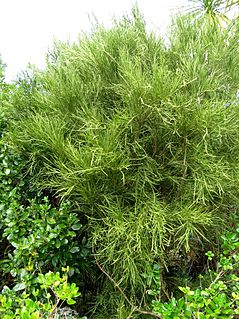
Carmichaelia is a genus of 24 plant species belonging to Fabaceae, the legume family. All but one species are native to New Zealand; the exception, Carmichaelia exsul, is native to Lord Howe Island and presumably dispersed there from New Zealand.

Carmichaelia carmichaeliae is a species of plant in the family Fabaceae. It is found only in South Island of New Zealand. It is classified as having the "Nationally Critical" conservation status under the New Zealand Threat Classification System.

Carmichaelia glabrescens is a species of plant in the family Fabaceae. It is found only in New Zealand.
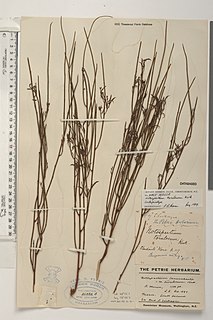
Carmichaelia torulosa is a species of plant in the family Fabaceae. It is found only in New Zealand.
Aceria clianthi is a species of mite belonging to the family Eriophyidae. It is found only in New Zealand. It is notable for being host specific to threatened plants of the genus Clianthus. It is classified by Buckley et al. as "nationally critical" under the New Zealand Threat Classification System. They stated "Aceria clianthi (Eriophyidae), has been recorded only from kakabeak in cultivation and once on Lotus cornalatus [Lotus corniculatus] (Fabaceae), an introduced plant growing near kakabeak. It is given the same threat classification as kakabeak ." Heenan had earlier stated that "the two species [of Clianthus] are considered to be threatened, with C. maximus having a rank of vulnerable, whereas C. puniceus is critically endangered", but the conservation status of C. maximus was subsequently found to be more serious. These threat classifications for Clianthus apply to plants in the wild, but the species are widely cultivated. Aceria clianthi occurs on both plants in the wild and in cultivation.
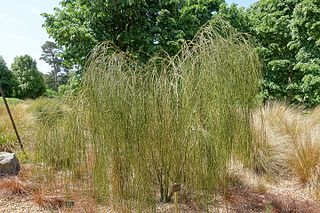
Carmichaelia stevensonii, the cord broom or weeping broom, is a species of plant in the family Fabaceae. It is found only in the north east of the South Island of New Zealand. It is threatened by habitat loss.

Carmichaelia muritai, common name coastal tree broom, is a species of plant in the family Fabaceae. It is found only in the South Island of New Zealand.
Montigena is a genus of flowering plant in the legume family Fabaceae, comprising a single species of dicotyledonous herb native to New Zealand, known as Montigena novae-zelandiae or more commonly the scree pea. The plant is small and woody, arising from thin, branched stems that extend to the surface from a deeply buried root stock. The flowers vary from purple to brown, while fruits appear between January and April.
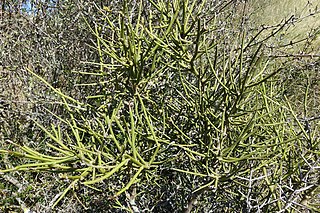
Carmichaelia petriei is a species of New Zealand broom belong to the genus Carmichaelia. It is endemic to New Zealand. C. petrieis is possibly a host plant for the critically endangered fungus weevil Cerius otagensis.

Samana acutata is a species of moth in the family Geometridae This species is endemic to New Zealand. It is classified as "At Risk, Relict" by the Department of Conservation.
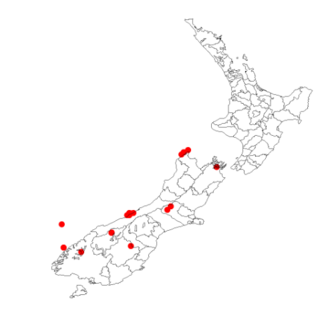
Carmichaelia juncea, the braided riverbed broom, is a species of New Zealand broom, a prostrate shrub in the family Fabaceae that is endemic to New Zealand. It is extinct over much of its former range, including the North Island.

Carmichaelia curta is a species of plant in the family Fabaceae. It is found in New Zealand. It is classified as having the "Nationally Critical" conservation status under the New Zealand Threat Classification System.

Carmichaelia appressa is a species of pea in the family Fabaceae. It is found only in the South Island of New Zealand. Its conservation status (2018) is "At Risk - Naturally Uncommon" under the New Zealand Threat Classification System.
George Simpson (1880–1952) was a New Zealand naturalist and botanist. He was born in Dunedin, the son of a master builder. He, too, became a builder and valuer, working as Crown Valuer from about 1943 until early 1950. However, he, together with John Scott Simpson, became interested in collecting and growing New Zealand native plants and by 1925 both were well known within the New Zealand botanical community.

Carmichaelia australis, or common broom, is a species of pea in the family Fabaceae. It is native to New Zealand and found in both the North and South Islands. Its conservation status (2018) is "Not Threatened" under the New Zealand Threat Classification System.
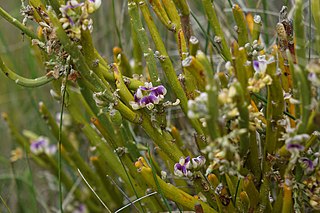
Carmichaelia hollowayi is a species of plant in the family Fabaceae. It is found only in the South Island of New Zealand. Its conservation status (2018) is "Nationally Critical" under the New Zealand Threat Classification System.
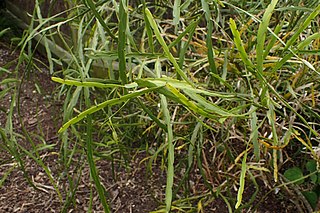
Carmichaelia williamsii is a species of plant in the family Fabaceae. It is found only in the North Island of New Zealand. Its conservation status (2018) is "At Risk (relict)" under the New Zealand Threat Classification System.
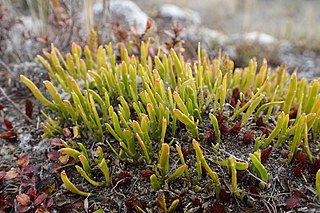
Carmichaelia nana is a species of plant in the family Fabaceae. It is found in both the North and South Islands of New Zealand. Its conservation status in 2013 was assessed as "At Risk (declinining)" under the New Zealand Threat Classification System, but in 2018 its risk under the same system became "Threatened-Nationally Vulnerable".
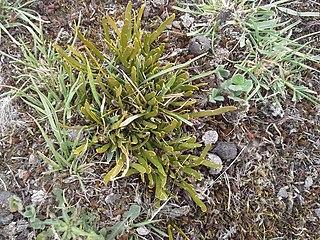
Carmichaelia corrugata is a species of plant in the family Fabaceae. It is found only on the South Island of New Zealand.

Tupeia is a monotypic genus of semi-parasitic shrubs (mistletoes) which occurs in both the North and South Islands of New Zealand. There is only one species in the genus: Tupeia antarctica. There are no synonyms.



















